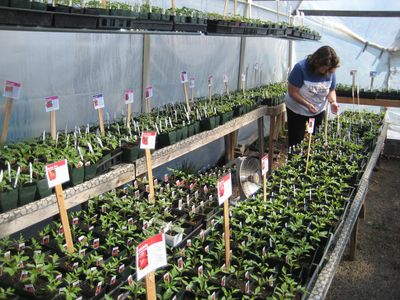Water, soil, ‘The Tomato Lady:’ Three keys to a successful crop

If there’s such a thing as the king of vegetables, it’s got to be the tomato. I’m sure most would agree there is nothing quite so delectable as a sun-ripened tomato, fresh from the garden.
I recently caught up with Elizabeth Casteel – known by many as “The Tomato Lady” – to learn her tomato-growing secrets.
Casteel sells thousands of tomato seedlings through her Web site ( www.thetomatolady.com) and will sell plenty more at the Garden Expo next Saturday at Spokane Community College.
But make sure you get there early because she traditionally sells out by 10 a.m.
On March 11, Casteel planted 4,000 tomato seeds from 115 different varieties in flats inside her Spokane Valley home.
“This year I’m growing every color of tomato but blue,” she says.
Once the seedlings have their true leaves about two weeks later, she transplants them into pots filled with a custom mix of potting soil, Osmocote fertilizer, steamed bone meal and a water-retaining polymer.
Then the seedlings head out to her 10- by 40-foot greenhouse to soak up the daytime sunshine. They are kept warm by a heater at night.
A week later, she sprays the seedlings lightly with seaweed extract. From that point on, she just has to keep them watered consistently.
How does Casteel pick her tomato varieties?
“I choose varieties I like, including heirlooms which can be harder to grow, varieties my customers request and I am easily influenced by the pretty pictures (in the catalogs),” she says.
“I don’t select varieties that need longer than 100 days to mature, although I don’t put much stock in the days-to-maturity information because that can really vary depending on the weather and growing conditions each year.”
Casteel feels the ideal time to plant tomatoes out in the garden is right around Mother’s Day, “but I watch the weather like a hawk,” she adds. “You have to protect them, and if you aren’t able to do that, wait until the end of May.”
The seedlings should be planted deep – up to the lowest leaves – to encourage additional root growth along the main stem.
Casteel grows her tomato plants in raised beds and keeps them warm by using flexible electrical conduit hoops and plastic sheeting to create “little hoop houses” over them.
“You can also take plastic milk jugs, cut off the bottoms and cover your tomatoes with them at night,” she says. “But don’t leave the jugs on during the day or the plants will burn.”
What advice does she have for anyone new to growing tomatoes?
“Good soil preparation is the key so be sure to use compost or well-composted manure in your planting beds,” Casteel says. “Consistent watering is critical for productive plants as well as providing the plants with fertilizer. But most of all, tomato plants need lots and lots of light, at least eight hours a day.”
If you don’t have space for a garden, you can still grow tomatoes in containers.
“Get the biggest container you can buy,” Casteel advises, and select determinate varieties like Micro-Tom, Totem, Vilma and Patio.
“Determinates will grow to a height of 4 feet and produce a flush of tomatoes at once,” she explains.
“Always use good quality potting soil – never garden soil – and make sure you water, water, water,” Casteel adds.
She suggests fertilizing container plants weekly with a diluted fertilizer and putting the pot on casters so it can be moved during the day for the best sunlight.